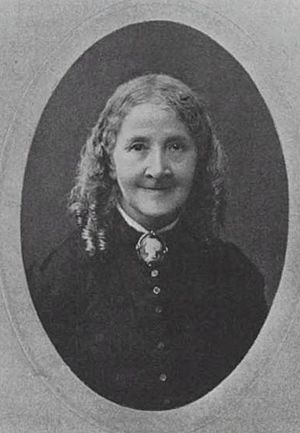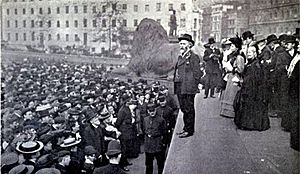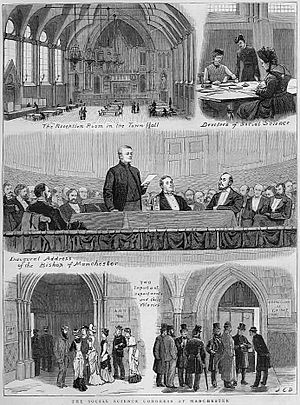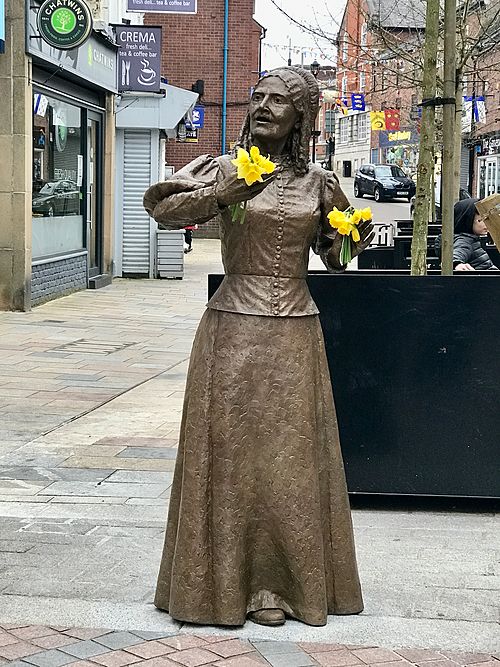Elizabeth Wolstenholme Elmy facts for kids
Elizabeth Clarke Wolstenholme Elmy (born 1833, died 12 March 1918) was a very important person who spent her whole life fighting for women's rights in the United Kingdom. She worked hard to help women get the right to vote, which is called women's suffrage. She also wrote essays and poems using the pen names E and Ignota.
Contents
Elizabeth's Early Life
Elizabeth Wolstenholme grew up in villages and towns that are now part of Greater Manchester. She was born in Cheetham Hill and was baptized in Eccles in 1833. Her mother, also named Elizabeth, died soon after she was born. Her father, Joseph Wolstenholme, was a Methodist minister. He passed away before Elizabeth turned 14.
Her older brother, Joseph Wolstenholme, got a good education and became a math professor at Cambridge University. But Elizabeth was only allowed to study for two years at Fulneck Moravian School.
Even with limited schooling, she kept learning on her own. She became the headmistress of a private boarding school for girls in Boothstown, near Worsley. In 1867, she moved her school to Congleton in Cheshire.
Fighting for Change
Elizabeth was very upset about how bad girls' education was. In 1862, she joined the College of Preceptors, an organization for teachers. There, she met Emily Davies. Together, they worked to make sure girls could go to college just like boys.
In 1865, Elizabeth started the Manchester Schoolmistresses Association. A year later, in 1866, she spoke to the Taunton Commission. This group was looking at how to improve schools. Elizabeth was one of the first women ever to speak to a special committee in Parliament (the UK's government).
Elizabeth and Emily Davies later disagreed about how women should be tested for higher education. Elizabeth wanted a curriculum that would help women get jobs. Emily wanted women to study the exact same things as men.
Campaigning for Women's Vote
In 1866, Elizabeth started the Manchester Committee for the Enfranchisement of Women. This began 50 years of strong campaigning for women's suffrage, which is the right for women to vote.
In 1871, she stopped running her school. She became the first person to be paid by the women's movement. Her job was to talk to Parliament about laws that were unfair to women. People called her 'the Scourge of the Commons' or the 'Government Watchdog' because she took her job so seriously.
When other women's suffrage groups struggled, Elizabeth helped keep the movement strong in Manchester. In 1867, her committee regrouped as the Manchester Society for Women's Suffrage.
In 1877, all the women's suffrage groups came together to form the National Society for Women's Suffrage. Elizabeth was a founding member of another group, the Women's Franchise League, in 1889. She later left that group and started the Women's Emancipation Union in 1891.
Women's Emancipation Union (1891–1899)
Elizabeth founded the Women's Emancipation Union (WEU) in September 1891. This happened after an important court case where a wife was freed from her husband's control. Elizabeth saw that this case showed how unfair the old law of "coverture" was. This law meant that a wife's legal identity was taken over by her husband's.
The WEU worked to get four main types of equality for women:
- Equal rights and duties as citizens.
- Equal chances in education and personal growth.
- Equal opportunities in the workplace.
- Equal rights in marriage and as parents.
The WEU held annual conferences and many public meetings. They had organizers in different cities and over 7,000 international members. They also encouraged women to vote and run for local government positions once they were allowed to.
After a law called the Local Government Act 1894, the WEU helped women who owned property to run for local offices or at least to vote. More than 100 WEU organizers were elected to local government roles.
The WEU eventually closed down in 1899 after losing its main supporter and having fewer members.
Working with the WSPU
Elizabeth Wolstenholme was a friend of Emmeline Pankhurst, who led the Women's Social and Political Union (WSPU). The WEU is now seen as an early version of the WSPU, which was known for its more active and sometimes "militant" methods.
Elizabeth was on stage when important leaders spoke to a large crowd in Trafalgar Square in 1906. She also wrote about other big meetings. In the Women's Coronation Procession in 1911, she was called 'England's oldest' suffragette.
However, Elizabeth left the WSPU in 1913 because their actions became too violent and threatened people's safety.
Other Important Work
In 1913, Elizabeth became vice-president of the Women's Tax Resistance League. She also supported the Lancashire and Cheshire Textile and other Workers' Representation Committee, which was formed in Manchester in 1903.
Elizabeth didn't just focus on one issue. She wanted men and women to be equal in all ways. She was the secretary for the Married Women's Property Committee from 1867. This committee helped pass the Married Women's Property Act 1882, which gave married women more control over their own money and property.
In 1869, Elizabeth asked Josephine Butler to lead a group that fought against unfair laws affecting women's health. This campaign was successful in 1886. In 1883, Elizabeth worked for the Guardianship of Infants Committee, which led to a law in 1886 that helped mothers have more rights over their children.
Elizabeth's Personal Life
Elizabeth met Benjamin John Elmy (1838 - 1906) when she moved to Congleton. He owned a silk mill and believed in secularism (not following religious rules) and republicanism (not having a king or queen). He was also a feminist, meaning he supported women's rights. They became partners and soulmates.
Benjamin Elmy became very active in the women's movement, joining Elizabeth's committees. They started living together in the early 1870s. When Elizabeth became pregnant in 1874, her colleagues were upset and insisted they get married, even though Elizabeth and Benjamin didn't believe in marriage. They had a civil ceremony in 1874, but Elizabeth had to leave her job in London.
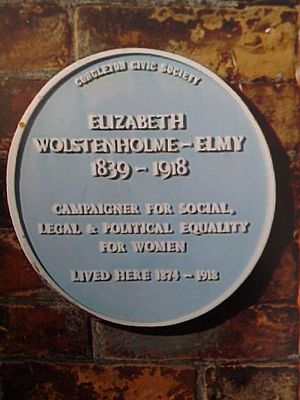
The Elmys moved to Buxton House in Buglawton. Their son, Frank, was born there in 1875. They were comfortable but not rich, and Frank was taught at home.
In 1886, Benjamin Elmy was elected to lead a group that supported protecting British industries. Both Elizabeth and Benjamin often spoke out against free trade laws. Benjamin's business closed in 1888, and he retired in 1891 due to poor health. In 1897, he started the first group for men who supported women's right to vote.
Elizabeth and Benjamin remained married until he died in 1906. Elizabeth died on 12 March 1918. Her funeral was held in Manchester.
Even though Elizabeth's work was recognized during her lifetime, she has sometimes been forgotten in the history of the women's movement.
Elizabeth's Writings
Elizabeth wrote a lot! She wrote papers for the National Association for the Promotion of Social Science and articles for feminist magazines like Shafts and newspapers like the Westminster Review. She also published pamphlets about her campaigns through groups like the Women's Emancipation Union.
Some of her most important writings include:
- The Report of the Married Women's Property Committee (1882).
- The Infants' Act 1886 (1888), which explained the efforts to change laws for children.
- The Enfranchisement of Women (1892), published by the Women's Emancipation Union.
The British Library keeps her papers and documents from her work on the Guardianship of Infants Act and the Women's Emancipation Union.
Elizabeth also wrote poetry. Her poem 'The Song of the Insurgent Women' was published in 1906. As 'Ignota', she wrote 'War Against War in South Africa' in 1899, during the Second Boer War.
How Elizabeth is Remembered
A blue plaque (a special sign) was put on her home, Buxton House, by the Congleton Civic Society. It says: "Elizabeth Wolstenholme-Elmy 1839–1918 Campaigner for social, legal and political equality for women lived here 1874–1918."
Her name and picture, along with 58 other women who supported women's suffrage, are carved into the base of the statue of Millicent Fawcett in Parliament Square, London. This statue was revealed in 2018.
In April 2021, a new road in Congleton was named Wolstenholme Elmy Way in her honor.
A charity called Elizabeth's Group was started in Congleton in 2019 to help more people learn about her. This group raised money to create a statue of Elizabeth. It was designed by sculptor Hazel Reeves and was revealed by Baroness Hale of Richmond on International Women's Day, 8 March 2022.
See also
 In Spanish: Elizabeth Wolstenholme Elmy para niños
In Spanish: Elizabeth Wolstenholme Elmy para niños


